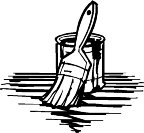 Proper Paint Disposal
Proper Paint Disposal
Paint, stain, varnish, or other coating that has a label stating "Flammable," "Caution," "Warning," or "Danger" must be disposed of properly, using the UnderTheSink facility available for Douglas and Sarpy County residents.
Latex paint and all paints that are thinned with water are not hazardous in any way and can safely be disposed of in the trash if first dried out.
Follow these simple instructions to dry out unwanted latex (water based) paint before placing in your garbage.
Items that you need:
-
- A low, flat box, approximately the size of a shirt box. A soda flat works well, but most any box will do.
- Absorbent material, such as kitty litter, sand or dirt. The amount you need depends on how much paint you have to dry out.
- A stick to stir the paint.
- Newspaper to line the box.
- A clear plastic bag for final disposal.
Take it step-by-step
Please read all instructions before starting.
-
- Collect all needed materials: All of the materials listed above should be ready for use when you start. Make sure you have enough of each item to complete the job.
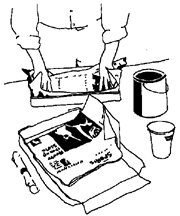
- Line the box: Open one section of newspaper (so that you are able to read the middle two pages of the section). Line each box with an open newspaper.
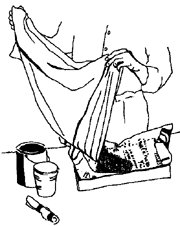
- Fill with absorbent material: Pour a oneinch layer of absorbent material into the newspaperlined box. Spread the material to make an even layer.
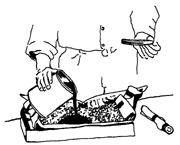
- Pour the liquid: Pour the unwanted paint on the absorbent material. The amount of paint will vary depending on the type of absorbent material you are using. It is best to start with a small amount of paint, and add more paint if the absorbent material can handle it.
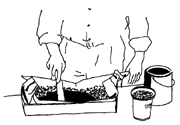
- Mix the materials: Stir the paint and absorbent material. All of the pieces of absorbent material should be well covered with paint. If not, continue to stir or add more paint if you have more to dispose.
- Time to dry: Allow the paint adequate time to dry in a well-ventilated area away from children and pets. It could take several hours or several days for the paint to dry. The amount of time needed depends on the amount of paint absorbed, the amount of ventilation, the surrounding temperature and the humidity.
- Repeat if necessary: Repeat steps 2 through 6 until all of your paint is mixed with absorbent material and in boxes.
- Empty the can: Be sure to scrape out as much paint as possible from the paint can.
- Box it up: After all of the paint is dry, fold the newspaper that extends out of the box down over the dried out paint. Combine any other boxes of dried out paint.
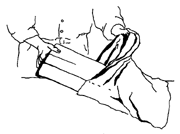
- Bag it up: Once the paint is dry, place the box, stir stick and any other paint covered items in a clear plastic bag. Close the bag, and place with your household trash.
- Recycle/Dispose: The empty paint can, may be recycled in Omaha’s curbside recycling bin. Dispose of the paint can lid in your garbage.
Storage Recommendations:
The American Coatings Association (ACA) is the trade industry for paint manufacturers. They contend that paint can be stored for years if put away properly. The key to keeping paint fresh is a tight seal on the container. To do this, ACA recommends
- Clean both the lid and the can rim by removing wet and dried out paint
- Cover the paint can opening with a piece of plastic wrap, then place the lid back onto the container over the plastic wrap. Use a rubber mallet to seal the lid tightly. If a rubber mallet is not available, use a small piece of wood to absorb the blows of a regular hammer and protect the lid.
- Store the container upside down in a room that will not allow the paint to freeze.
The paint should be kept away from heat as well as children and pets.
Tips About Paint:
- Paint that is still usable may be shared with friends, neighbors and charities that need paint. Usable paint is paint that is still a liquid, has not been frozen, and has an appropriate odor. Unusable paint will have at least one of these symptoms: a foul odor, a consistency of cottage cheese or is hard. Disposal is the only option for unusable paint.
- Measure the surface to be painted carefully and buy only the amount of paint you need to complete the job. Ask the store clerk to help you estimate the amount of paint needed. The clerk will ask you for the dimensions of the room or building to determine the amount of paint needed.
- Buy low toxicity paint. In today's tightly constructed homes, the smells given off by paint can make people ill. Low toxicity paints have been developed to alleviate this problem. By federal law, all lead has been removed from household consumer paints.
- Companies are developing recycled paint! Watch for it. Ask for it.
- UnderTheSink has paint available in the ReStore that other citizens have turned in. You may find just what you need for your project.
- The procedures and methods presented here are for informational purposes only. Without regard to the methods or precautions utilized, none of the governmental agencies, nor any of the organizations listed herein, assume any liability for damage or injury resulting from the handling, transferring, or disposal of any hazardous or potentially hazardous item, solid, liquid or gas.